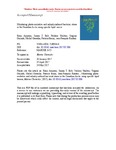Monitoring photo-oxidative and salinity-induced bacterial stress in the Canadian Arctic using specific lipid tracers
| dc.contributor.author | Amiraux, R | |
| dc.contributor.author | Belt, Simon | |
| dc.contributor.author | Vaultier, F | |
| dc.contributor.author | Galindo, V | |
| dc.contributor.author | Gosselin, M | |
| dc.contributor.author | Bonin, P | |
| dc.contributor.author | Rontani, J-F | |
| dc.date.accessioned | 2017-07-26T15:50:45Z | |
| dc.date.issued | 2017-08-20 | |
| dc.identifier.issn | 0304-4203 | |
| dc.identifier.issn | 1872-7581 | |
| dc.identifier.uri | http://hdl.handle.net/10026.1/9641 | |
| dc.description | Publisher policy: author can archive post-print on open access repository after an embargo period of 18 months.Publisher's version/PDF cannot be used. Must link to publisher version with DOI. Author's post-print must be released with a Creative Commons Attribution Non-Commercial No Derivatives License. | |
| dc.description.abstract |
We determined, and compared, the abiotic stress state of algae and their attached bacterial communities following their release into the water column during the Arctic sea ice melt season using specific lipid markers that are characteristic of type II photo-oxidation processes, together with those associated with cis-trans isomerase and 10S-DOX-like lipoxygenase activity, which are indicative of salinity stress. More specifically, parent lipids and some of their oxidation products were quantified in sinking particles (from sediment traps) collected from the Beaufort Sea, Resolute Passage and the Davis Strait (Canadian Arctic) in 2009, 2012 and 2015, respectively. Our data show that salinity- and light-induced bacterial stress processes are temporally decoupled, with the former occurring at the beginning of ice melting and the latter observed during the final stages of ice melt and in subsequent open waters. The salinity-induced bacterial stress seen during the early stages of ice melting contrasts the healthy state of sea ice algae under the same hypersaline conditions. As sea ice melt progresses, brine channels become hyposaline, thus reducing the bacterial salinity stress, while ice algae become susceptible to photodegradation by singlet oxygen (1O2), despite relatively low temperatures and irradiance. However, the presence of high amounts of extracellular polymeric substances (EPS) encapsulating the algae likely prevents the diffusion of 1O2 to the attached bacteria. Photo-oxidative stress is enhanced further in open waters due to the low amounts of EPS. The lower amounts of active bacteria in the Arctic compared to temperate or tropical regions is thus attributed to the combined action of efficient salinity stress in spring and photo-oxidative stress in summer. Outcomes from this study also imply that surface sediments from the Canadian Arctic contain relatively high quantities of sea ice-derived organic matter that has undergone a strong degree of salinity-induced stress. | |
| dc.format.extent | 89-99 | |
| dc.language | en | |
| dc.language.iso | en | |
| dc.publisher | Elsevier BV | |
| dc.subject | Light stress | |
| dc.subject | Salinity stress | |
| dc.subject | Lipid biomarkers | |
| dc.subject | Cis-trans isomerase | |
| dc.subject | 10S-DOX-like lipoxygenase | |
| dc.subject | Bacteria | |
| dc.subject | Ice algae | |
| dc.subject | Phytoplankton | |
| dc.subject | EPS | |
| dc.subject | Arctic environment | |
| dc.title | Monitoring photo-oxidative and salinity-induced bacterial stress in the Canadian Arctic using specific lipid tracers | |
| dc.type | journal-article | |
| dc.type | Journal Article | |
| plymouth.author-url | https://www.webofscience.com/api/gateway?GWVersion=2&SrcApp=PARTNER_APP&SrcAuth=LinksAMR&KeyUT=WOS:000412615500009&DestLinkType=FullRecord&DestApp=ALL_WOS&UsrCustomerID=11bb513d99f797142bcfeffcc58ea008 | |
| plymouth.volume | 194 | |
| plymouth.publication-status | Published | |
| plymouth.journal | Marine Chemistry | |
| dc.identifier.doi | 10.1016/j.marchem.2017.05.006 | |
| plymouth.organisational-group | /Plymouth | |
| plymouth.organisational-group | /Plymouth/Faculty of Science and Engineering | |
| plymouth.organisational-group | /Plymouth/Faculty of Science and Engineering/School of Geography, Earth and Environmental Sciences | |
| plymouth.organisational-group | /Plymouth/REF 2021 Researchers by UoA | |
| plymouth.organisational-group | /Plymouth/REF 2021 Researchers by UoA/UoA07 Earth Systems and Environmental Sciences | |
| plymouth.organisational-group | /Plymouth/Research Groups | |
| plymouth.organisational-group | /Plymouth/Research Groups/Marine Institute | |
| plymouth.organisational-group | /Plymouth/Users by role | |
| plymouth.organisational-group | /Plymouth/Users by role/Academics | |
| plymouth.organisational-group | /Plymouth/Users by role/Researchers in ResearchFish submission | |
| dcterms.dateAccepted | 2017-05-24 | |
| dc.rights.embargodate | 2018-11-25 | |
| dc.identifier.eissn | 1872-7581 | |
| dc.rights.embargoperiod | 18 months | |
| rioxxterms.versionofrecord | 10.1016/j.marchem.2017.05.006 | |
| rioxxterms.licenseref.uri | http://www.rioxx.net/licenses/under-embargo-all-rights-reserved | |
| rioxxterms.licenseref.startdate | 2017-08-20 | |
| rioxxterms.type | Journal Article/Review |


